
Crazy Cars III
Written by: Rik
Date posted: September 9, 2013
- Genre: Racing
- Developed by: Cistar
- Published by: Titus
- Year released: 1992
- Our score: 5
Regular readers (if, indeed, they exist) will by now be aware of our trademark blundering into the middle of a series of games with little care for chronology. And so, you join us now for a look at the third and final title of Titus’ trilogy of Crazy Cars games, none of which have, until this point, been covered on this site before. At the time of writing, though, this is the only one we’re ever likely to review. The original Crazy Cars, I can dimly recall playing on my Amstrad CPC, although the main memory was that of a multi-load cassette nightmare (kids, ask your parents). The first sequel, meanwhile, involved driving a Ferrari F40 along barren highways populated only by police cars, and was undermined by a fatally wobbly mouse-based control scheme. Beyond that, I’m not sure there’s much else I want to say about them here.
Still, if I wanted to avoid all the trouble of mentioning them at all, I could always have chosen the marginally-improved re-release, Lamborghini American Challenge, for consideration here, but I haven’t, because Crazy Cars III is the game I once owned and want to write about, and because I’m slightly prejudiced against sneakily re-branded updates of previously released games from this era. But, if you want to know a little more about the later game, there’s something for you in the extras section.
The setup for Crazy Cars III is as follows: you arrive in the US dreaming of becoming a millionaire. As your only skill is driving, you must achieve this dream through illegal street racing. Fortunately, a friend of yours has fallen upon hard times and so agrees to sell you his Lamborghini Diablo at a low, low price. Still, this rather eats into your savings, leaving you with only a few thousand dollars with which to enter the fourth division of the street racing championship. I suppose the fairest thing you can say about that (which was fairly closely paraphrased from the manual itself) is that it’s no worse than the kind of stuff you get from high-budget modern racers, around which entire scripts have been written and recorded at great expense (but to no greater effect than a couple of paragraphs hastily added to the instruction booklet).
Anyway, you have a Lamborghini and a little bit of cash, which you’ll need to enter races. If you win, you receive prize money. You can also choose to gamble on the outcome of the race with rival racers. If you’re successful, you can use your winnings you repair and upgrade your car, and enter more races. Once you no longer have enough money to enter a race, then it’s game over. If, on the other hand, you earn enough spare cash, you can buy a pass for the division challenge, and if you beat that you can move up to the next division of the championship. Each race has an entry fee and prize money which roughly equates to how tough it will be to win. When choosing a race you’ll also be shown which rival racers will be entering, the skill level of the local racers (who make up the rest of the field) and the chances of police attention (more on which shortly).
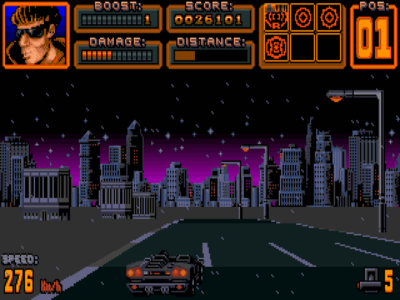
You can upgrade your car to a roadster, which supposedly has better cornering. Unfortunately it’s also a dull shade of grey.
Out on the road, you start in 10th place (which you assume is at the back of the field until you mess up a race so royally that you find yourself in 14th). You have the length of the race to get to the front, and the distance remaining is indicated by a bar on the HUD. As the races take place on public highways, you’ll also have civilian traffic to contend with, and, as is the tradition, they generally meander across the road in front of you and get in your way. A further complication is the presence of the highway patrol – if they catch you speeding, then they’ll give chase and prove a more formidable distraction. They don’t do much except get in front of you and block you, but as collisions slow you down and cause damage to your car, and maximum damage means that you have to stop, that’s more than enough to endanger your chances of winning. If you’re forced to stop when the police are chasing you, then you’re off to jail and face a fine to get out.
Taking its cue from the likes of Outrun, this is an arcade racer with a long streaming road ahead of you that bends and undulates to various degrees to make things more interesting. You’re not likely to learn any of the courses (there’s a training mode here but I think that’s designed more to give an opportunity for general practice) and so the focus is on your reactions in terms of drifting around corners, not losing speed, and avoiding the traffic drones that slow you down and cause damage. Unlike Outrun, though, there’s no time limit (although having to get to the front by the end of the race offers a similar type of challenge) and no collision is so severe that your car crashes and you have to get up to speed from a standing start.
Armed with this understanding, and the knowledge that the whole game can be controlled with the four arrow keys, getting a grip of the basics is fairly straightforward, and winning initial races isn’t all that difficult. Having said that, though, the 4th division is by far the most challenging to get out of: you have limited money, and opportunities to get significantly more than the minimum you need to progress are equally in short supply. Upgrades are expensive and you’re given little information on what they do or whether you’re likely to need them. Also, you can’t save your game until you beat the division challenge. So, while you get acquainted with things, you might find yourself having to go through the first hour or so over and over again while you learn the hard way.
This is undoubtedly extremely irritating at first, although you might argue that it acts as a refreshing counterpoint to modern racers, where your hand is held every step of the way and upgrades are only unlocked at the point at which you need them. Here, decisions have consequences, and failures endured and lessons learned at the outset will serve you well later in the game. With that in mind, I’ll stop short of offering detailed hints and tips, but I will say that you’ll rarely regret upgrading your car to make it go faster. The game manual (worth grabbing from the guys at Lemon Amiga) gives you some spiel about catching up to faster rivals using superior cornering techniques, but ensuring that you have the edge in straight-line speed is a surer way to get ahead. Another tip straight from the developer’s mouth is to avoid upgrading your car in order to bait your rivals into betting more money on a race. It is true that they’ll be scared off by a superior vehicle, but it’s not a risk worth taking for the extra money you’d earn.
Another relatively inexpensive upgrade is the radar detector, which warns of police ahead. It’s touch and go as to whether you can slam on the brakes in time to reduce your speed enough to avoid detection, but even if you only manage to do it half the time, it’s still worth not having to worry about the chase. Again, there are some strategies detailed in the manual about tricking the cops into chasing your rivals and not you, but they’re tricky to pull off with any precision, and in any case, irritating as the police are, they don’t often force you to pull over. Speed cameras also feature later on in the game – they can land you with a hefty fine, which is annoying, but you’d be hard-pressed to be able to hit the brakes in time to dodge one, so you may as well just plough on through or slow down as best you can (I think your speed dictates how big the fine will be).
Anyway, once you have enough money (and this doesn’t necessarily mean you have to have completed all available races) you can buy a set of three passes to have a go at the division challenge. This is actually a brief and bizarrely low-key sub-game which involves overtaking trucks, and doesn’t present much of a problem in itself, although the passes are pretty expensive, so you pretty much need to nail it in three goes. Once you do, you’ll be up to the next division, at which point you’ll do most of the same things again.
When you’re past the fourth division, things get much easier, which is a relief, not just because, as noted, you can’t save mid-division, but also because there’s not much variety, and by this point you’ll have pretty much seen everything the game has to offer. The same seven or eight scenery sets rotate throughout the game, with some vague acknowledgement of geographical location, the graphics for the police and civilian traffic never change, and the end of division challenge is largely the same in each division. Meanwhile, the significance of your racing rivals fades as you progress, and increasingly the prize money on offer dwarfs any money you may or may not have made by betting on the outcome of the races. You’re occasionally shown a table of the top racers and a tally of points accumulated, or are told that a particular rival has had to bow out of the tournament, but this has no bearing on your progress in the game, which is ultimately won by completing the top division challenge. (Judging by their avatars, they’re an eclectic bunch, too, with a clown, a sumo wrestler, Michael Jackson, Uncle Fester from the Addams Family, Elvis, Johnny Rotten and, by my best guess, Jamie Lee Curtis featuring among your opponents).
Elsewhere, the tracks get more swervy and hilly, increasing your tendency to slide off-road, and the local opponents do become more tenacious in accordance with their rating (although do note that in the world of Crazy Cars III, ‘competent’ opponents are better than ‘good’ ones – which is the opposite of what you’d expect). The nature of the game means that you never really feel all that skilful, at least not in the way that you would in a racing game where you get to know the tracks and remember where you need to go fast and go slow. Having slagged off the likes of MegaRace for being an animation of a road that is slowed down and sped up with the game controls as a sprite skates along the top, it’s only fair to point out that this (to a lesser extent) also applies here. There’s some satisfaction in muddling through on reactions and gritted teeth, but it doesn’t match that of the more developed racer described above.
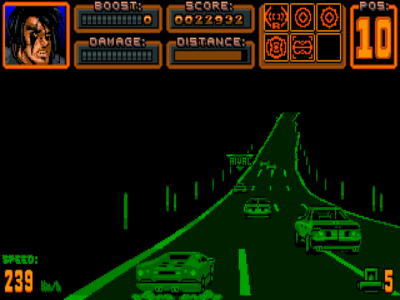
What use the night-vision goggles are, I couldn’t say. You certainly don’t need them to complete the game.
I mentioned Outrun earlier, and it’s worth pointing out that however much an entire generation of gamers might have wanted it, a decent home port never really happened. Crazy Cars III is just that, though – a good, home computer version of Outrun. Sure, it might not have the colourful scenery or the same variety of traffic or awesome music (although the one bit of music that is there is quite catchy), but it’s got the World’s Fastest CarTM and most of the rest is present and correct – and there’s a proper career mode and everything.
As far as this kind of thing goes, then, Crazy Cars III is pretty decent. I have to be honest and say that, although I received a copy of this for the Atari ST as a present for my 12th birthday (yes *sigh*, that’s 20 years ago now) I never really played it very much and chose to lazily parrot others’ positive opinions of it instead. Had it not been for the guilt associated with being both an ungrateful child and a lazy retro game loudmouth, I’m not sure whether I’d have persisted beyond the frustrating early stages, and I can’t say for certain whether it would be worth anyone else’s time to do so. However, despite the suspicion that the game would have been better served by a slightly more forgiving opening, I also suspect that Crazy Cars III deserved its reputation as one of the better racers on the Amiga and ST, certainly of this type at least (although my own nostalgia-tinged sympathies lie with the original Lotus Esprit Turbo Challenge).

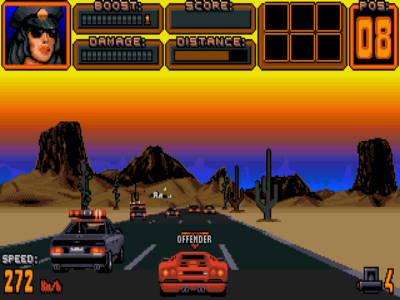
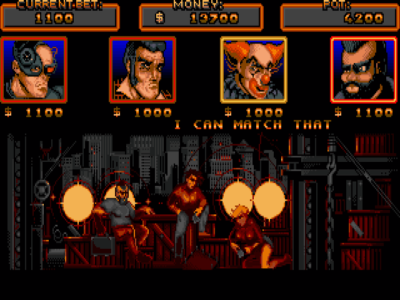
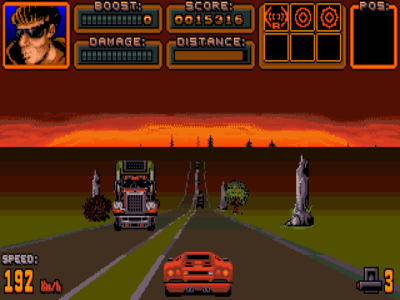

 Posts
Posts
I remember giving this one a try some time ago and utterly failing on said 4th division, ending up with cheating my way through the game (which wasn’t even half as entertaining as it promised to be). Well at least it was fun racing against a pseudo-Mr.T and it does have some fluid controls and graphics. So I agree with you, that it is one of the better Outrun-clones and it certainly deserves a lot more attention. So it’s nice it got a decent review. 😉
September 13, 2013 @ 9:53 pm
Hey Herr M, thanks for reading.
I was tempted to give up at various points in the 4th division, it’s true. You don’t see a lot else in the rest of the game, but it was satisfying to enjoy relatively easy progress and beat the thing after it initially caused so much frustration.
September 14, 2013 @ 1:07 pm
Somehow this game seems like a wasted oppoturnity to me: The concept (even if not that original) sounds good and the gameplay actually is quite nice, but the beginning is just too hard. And if the later divisions really are a bit easier, it’s a case of bad balancing too. At least I gave up on the game, because I thought that the later parts would be even harder. Well with that in mind, I might try it again someday, because nomally I really like racing games where you can upgrade your car.
September 18, 2013 @ 9:39 am
It’s entirely possible that Lamborghini American Challenge is better balanced but I haven’t played enough of it to find out.
September 18, 2013 @ 2:00 pm